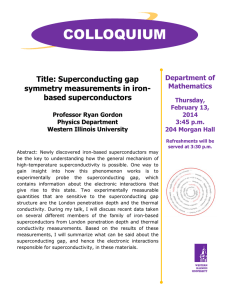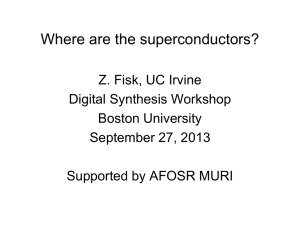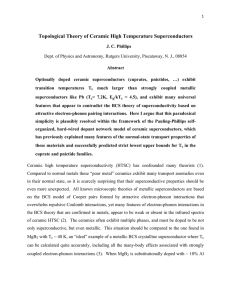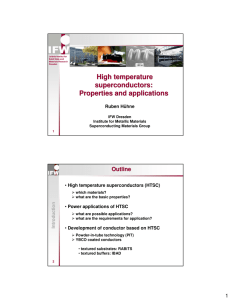3.13 SUPERCONDUCTIVITY superconductor: 1. ρ = 0
advertisement
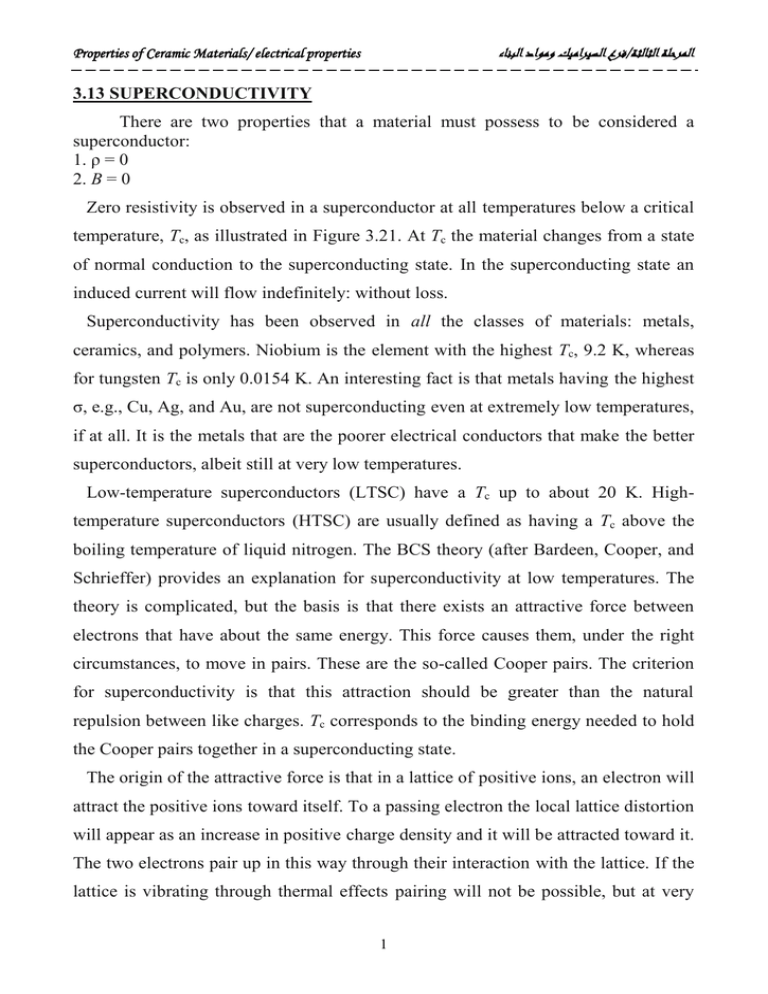
فرع السيراميك ومواد البناء/المرحلة الثالثة Properties of Ceramic Materials/ electrical properties 3.13 SUPERCONDUCTIVITY There are two properties that a material must possess to be considered a superconductor: 1. ρ = 0 2. B = 0 Zero resistivity is observed in a superconductor at all temperatures below a critical temperature, Tc, as illustrated in Figure 3.21. At Tc the material changes from a state of normal conduction to the superconducting state. In the superconducting state an induced current will flow indefinitely: without loss. Superconductivity has been observed in all the classes of materials: metals, ceramics, and polymers. Niobium is the element with the highest Tc, 9.2 K, whereas for tungsten Tc is only 0.0154 K. An interesting fact is that metals having the highest σ, e.g., Cu, Ag, and Au, are not superconducting even at extremely low temperatures, if at all. It is the metals that are the poorer electrical conductors that make the better superconductors, albeit still at very low temperatures. Low-temperature superconductors (LTSC) have a Tc up to about 20 K. Hightemperature superconductors (HTSC) are usually defined as having a Tc above the boiling temperature of liquid nitrogen. The BCS theory (after Bardeen, Cooper, and Schrieffer) provides an explanation for superconductivity at low temperatures. The theory is complicated, but the basis is that there exists an attractive force between electrons that have about the same energy. This force causes them, under the right circumstances, to move in pairs. These are the so-called Cooper pairs. The criterion for superconductivity is that this attraction should be greater than the natural repulsion between like charges. Tc corresponds to the binding energy needed to hold the Cooper pairs together in a superconducting state. The origin of the attractive force is that in a lattice of positive ions, an electron will attract the positive ions toward itself. To a passing electron the local lattice distortion will appear as an increase in positive charge density and it will be attracted toward it. The two electrons pair up in this way through their interaction with the lattice. If the lattice is vibrating through thermal effects pairing will not be possible, but at very 1 فرع السيراميك ومواد البناء/المرحلة الثالثة Properties of Ceramic Materials/ electrical properties low temperatures where the vibration amplitude is small, the attractive force can be dominant. The separation of the electrons in the pair (called the coherence length) for most LTSC is 100 nm. Interatomic spacings are on the order of 0.3 nm, so two bound electrons can be as far apart as 300 lattice spaces. The large coherence length means that defects such as dislocations, GBs, and impurities are too small to have much effect on superconducting behavior. The existence of these bound electron pairs alters the energy band diagram for a superconductor by introducing a small gap at EF, known as the superconducting gap, ∆. The difference in the band structure of a material in the superconducting state and in the non superconducting state is illustrated in Figure 3.22. The energy of this gap corresponds to the binding energy of the electron pairs. Energy 2∆is needed to break a Cooper pair. The relationship between ∆ and Tc is given by the BCS theory: (3.44) - For LTSC ∆ ~1 meV - For HTSC ∆ ~ 1–10 meV The BCS theory predicts an ultimate limiting value of Tc of 30 K for electron pairing via lattice vibrations (phonons). FIGURE 3.22 Band diagram for a superconductor. FIGURE 3.21 Plot of ρ versus T for a superconductor. 2 فرع السيراميك ومواد البناء/المرحلة الثالثة Properties of Ceramic Materials/ electrical properties 3.14 CERAMIC SUPERCONDUCTORS The earliest nonmetallic superconductors were NbO and NbN. Both materials have a rocksalt crystal structure. What was significant about the discovery of superconductivity in these materials (they are of no practical use) is that they linked the phenomenon to ceramics and cubic crystal structures. Superconductivity in a multicomponent oxide was first observed in SrTiO3. Although Tc was determined to be only 0.3 K, SrTiO3 has the very important perovskite structure, is the structural building block of all presently known HTSC. The beginning of HTSC started in 1986 with the discovery of superconductivity in the compound La2BaCuO4, which has Tc ~38 K. This discovery was of monumental importance because the classic BCS theory for superconductivity predicted a maximum value of Tc of only 30 K! Many more HTSC were simply obtained by systematic substitution of elements into the basic perovskite unit. The elements yttrium and lanthanum are interchangeable in terms of chemical properties although they differ in size. The same is true of strontium and barium in Group II of the periodic table. The idea behind the substitution of the large element for a smaller element was based on observations that Tc could be raised under an applied pressure. Substitution of a larger element for a smaller one was thought to produce an internalized pressure effect. Table 3.4 lists some of these compounds and their Tc. TABLE 3.4 Critical Temperatures of Some Ceramic Superconductors 3 فرع السيراميك ومواد البناء/المرحلة الثالثة Properties of Ceramic Materials/ electrical properties - The obvious difference is Tc. The fact that Tc ~102K means that the binding energy is ~10 meV, as compared to <1 meV in LTSC. - The ceramics have higher ρ than the metals at 100 K. But ρ is comparable to some of the best ceramic electrical conductors, such as CrO2 and TiO. - For HTSC χ is only ~1.0 nm, which means that the pairing behavior is almost on an atomic scale and the superconducting properties will be dependent on atomic scale defects. (Compare χ with the width of a dislocation or GB.) Such defects therefore scatter the electron pairs and reduce the critical current density. For metals χ is large, e.g., χ = 1.6 μm in pure Al, χ = 38 nm in pure Nb. - χ is anisotropic. For YBCO χab ~ 1.5 nm and χc ~ 0.4 nm. A major problem in HTSC is to find a crystal defect that pins the flux vortices, but does not disrupt current flow. Superconductivity essentially takes place within the CuO2 planes. The Cu–O chains can be considered as a “charge reservoir” that is needed to transfer charge into the CuO2 planes. Charge carriers are added by doping: adding oxygen to YBa2Cu3O6, which enters the compound as O2− and forms Cu–O chains. To maintain charge balance, electrons are removed from the Cu–O planes and the remaining holes are mobile (hence conduction) and form Cooper pairs below Tc. In LTSC Cooper pairs, with a charge of −2e, are responsible for current flow. In most of the HTSC the Cooper pairs have a positive charge, +2e. There are many potential applications for HTSC, but the actual realization of these has in many cases not occurred. The major problem is being able to fabricate the ceramics into useful and usable shapes. Ceramics are inherently brittle and this alone makes the fabrication of long wires and tapes extremely difficult. These would be essential for domestic and industrial power transmission. 4
